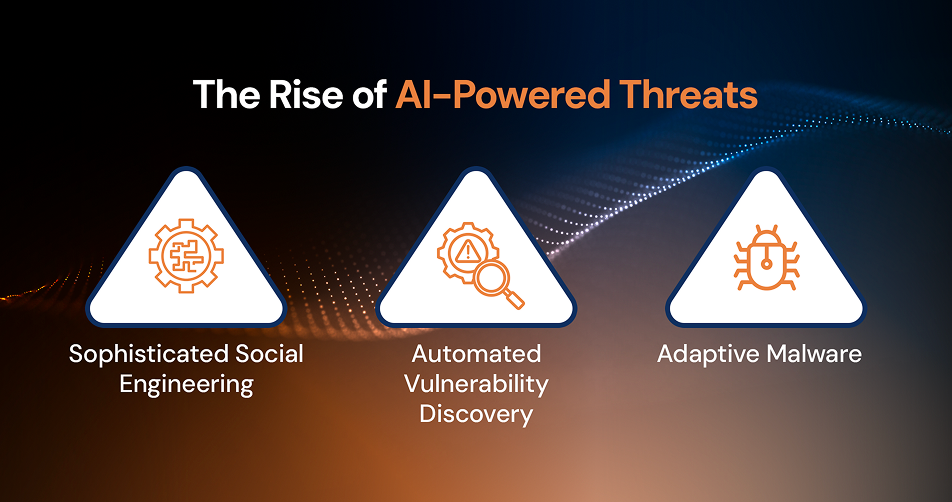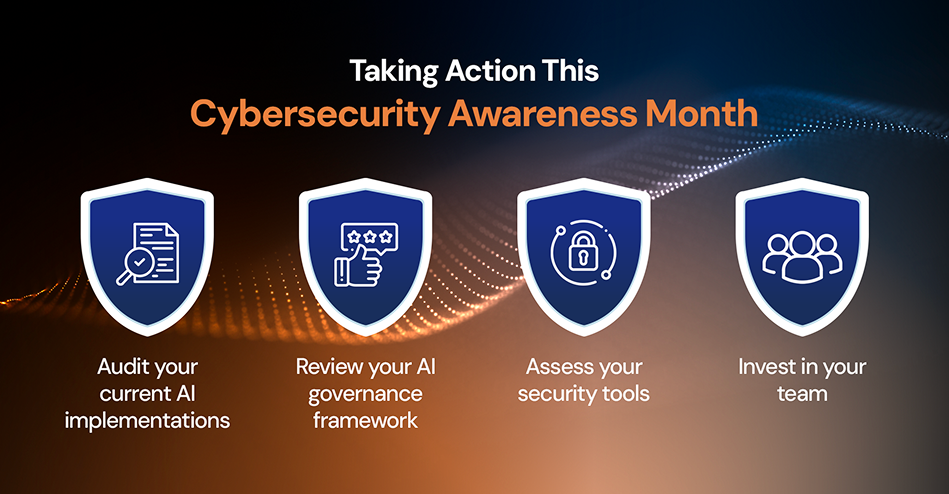Table of Contents
October marks Cybersecurity Awareness Month, and this year the conversation has fundamentally shifted. For the first time, enterprises face a unique paradox: they're rapidly adopting AI to drive innovation while simultaneously defending against increasingly sophisticated AI-powered threats. This dual reality defines the security landscape of 2025.
The AI Adoption Dilemma
Organizations are racing to integrate AI into their operations. Generative AI platforms, intelligent automation, and machine learning models have moved from experimental to essential. According to recent industry analyses, enterprises are deploying AI across customer service, operations, development, and decision-making processes at unprecedented speed.
But here's the challenge: every AI implementation expands your attack surface. Each integration point, data pipeline, and automated workflow represents a potential vulnerability. And threat actors know this.
While enterprises deploy AI for productivity, cybercriminals are weaponizing the same technology. AI-powered attacks are evolving faster than traditional security measures can adapt:
- Sophisticated Social Engineering: AI generates convincing phishing emails, voice clones, and deepfake videos that bypass human skepticism. These campaigns have levelled up from being generic spam to highly personalized, contextually aware attacks that study your organization's communication patterns.
- Automated Vulnerability Discovery: AI systems can scan codebases, identify weaknesses, and craft exploits faster than security teams can patch them. What once took skilled hackers weeks now happens in hours.
- Adaptive Malware: Modern threats use machine learning to evade detection, modifying their behavior based on the security environment they encounter.
The scale is staggering. Security operations centers now face an average of 960 alerts daily, with AI-generated threats comprising a growing percentage of that volume.

Shadow AI: The Hidden Risk
Perhaps the most overlooked vulnerability isn't external. It is internal. Shadow AI refers to AI tools and platforms deployed by business units without IT oversight or security review. When teams implement AI solutions to solve immediate problems, they often bypass governance protocols, creating security blind spots.
These unsanctioned tools may:
- Connect to sensitive corporate data without proper access controls
- Store information in unverified cloud environments
- Lack audit trails or compliance frameworks
- Create integration points that security teams don't monitor
Trying to combat this by simply blocking AI adoption is neither realistic nor beneficial. Organizations need visibility and governance frameworks that allow innovation while maintaining security.
Building Security Into AI-First Architecture: The DBiz.ai Approach
Securing an AI-first enterprise requires rethinking security architecture. Traditional perimeter-based approaches fail when AI systems continuously interact with data, users, and external services. This is where DBiz.ai's Platform Engineering methodology becomes indispensable.
- Security by Design: The Secure Landing Zone Foundation: We embed security considerations from the earliest stages of AI implementation. As certified Microsoft, AWS, and OutSystems partners, DBiz.ai establishes a Secure Landing Zone, which is a secure, pre-set cloud environment (AWS Secure Landing Zone, for instance) that ensures every new AI workload, data pipeline, or application starts with enterprise-grade security, proper governance, and compliance controls already in place. Security is the infrastructure's very foundation.
- Zero Trust for AI Systems: We apply zero trust principles specifically to AI implementations, integrating them into our Platform Engineering Framework. This includes validating data sources, authenticating API calls (especially for our multi-cloud clients using Azure and AWS), and continuously monitoring AI system behavior for anomalies.
- Continuous Monitoring: AI for Defense: AI systems operate at machine speed, and security monitoring must match that pace. Our AI-first approach helps leverage AI to:
- Analyze vast security data to identify patterns humans would miss.
- Automate initial threat triage, significantly reducing alert fatigue.
- Provide AI-powered threat detection and predictive insights for rapid response.
The Path Forward
Securing an AI-first enterprise facilitates achieving innovation and security simultaneously. Organizations succeeding in this environment share common characteristics: They embed security expertise into AI implementation teams rather than treating security as a separate function. They continuously educate teams about AI-specific security risks.
Most importantly, they recognize that AI security is a journey, not a destination. As AI capabilities evolve, so do the associated risks. Continuous adaptation, learning, and improvement are essential.
Taking Action This Cybersecurity Awareness Month
This October, use Cybersecurity Awareness Month as a catalyst for action:
- Audit your current AI implementations: Do you know every AI tool in use across your organization? Are they deployed within a DBiz Secure Landing Zone or a similarly fortified environment?
- Review your AI governance framework: Ensure your policies align with the agility of low-code platforms like OutSystems and the scale of AWS/Azure cloud environments.
- Assess your security tools: Are they equipped to detect and respond to AI-powered threats? Can they leverage the power of AI to accelerate incident response?
- Invest in your team: Ensure security professionals understand AI-specific risks, and that business units deploying AI understand their security responsibilities.
Organizations that master this balance are the ones that will lead. Stop choosing between innovation and security; make security the engine of your innovation. Partner with DBiz.ai to deploy secure, AI-driven solutions across Microsoft Azure, AWS, and OutSystems. This October, don't just raise awareness. Take action and start building your fortified, AI-first platform. See how our certified experts can transform your security posture.






